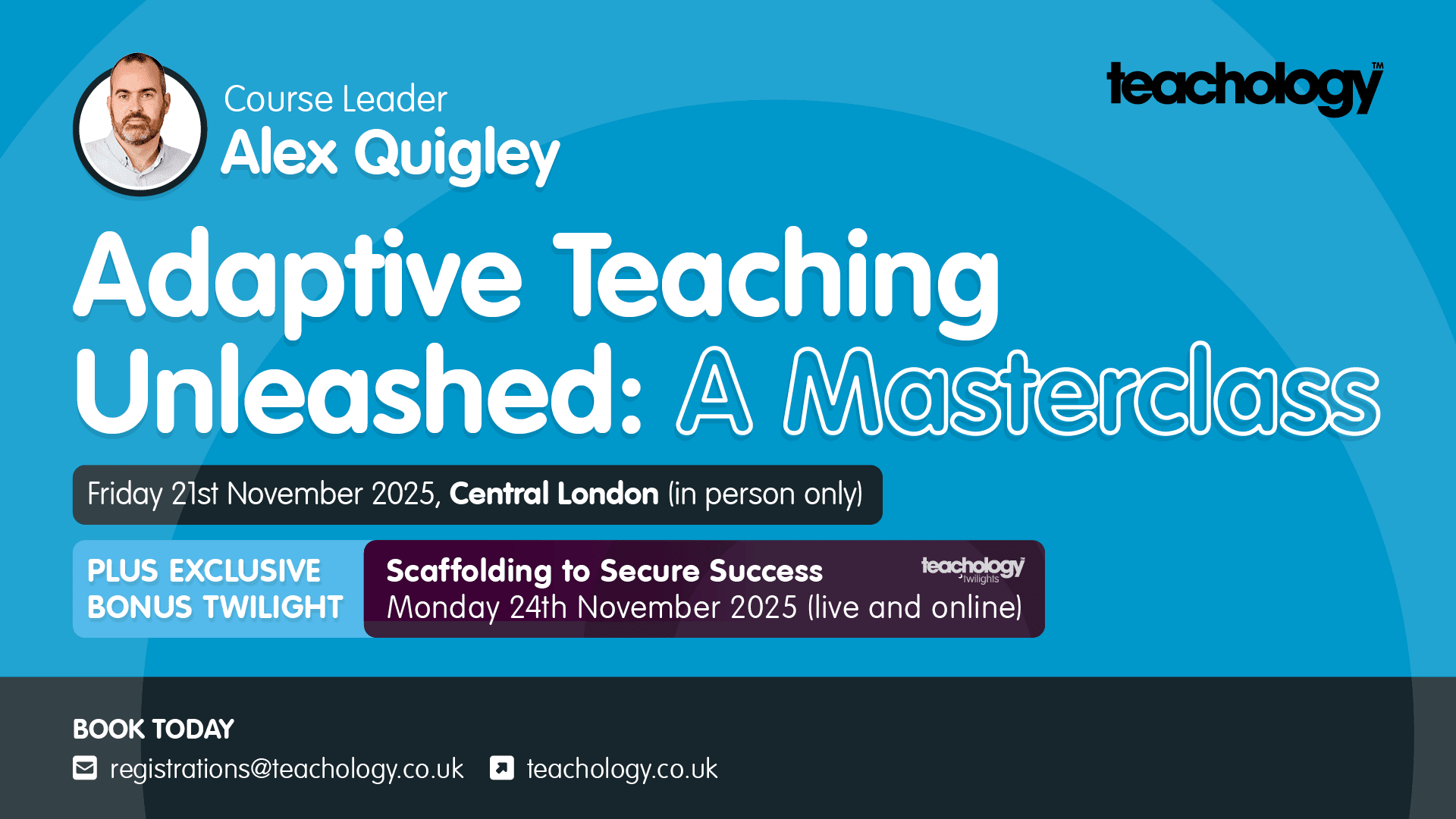"Scaffolds are not intended to be permanent. If everyone has a scaffold all of the time, it's not a scaffold, it's just your lesson plan."
'The Scaffolding Effect', by Rachel Ball and Alex Fairlamb
Teachers understand that scaffolds can be vital supports to tackle tricky tasks. For English teachers, as well as in subjects like history, business studies, and religious education, where extended analytical writing features – PEAL, and similar analysis structures – have been long-standing strategies to support students.
It is recommended on BBC Bitesize, as well as being promoted by some universities as a handy writing support.
But in recent years, there has been a backlash in some quarters against using scaffolds like PEAL too.
So, what should teachers do? Do paragraph plans, PEAL, and similar scaffolds have a place? Should we get rid and do things differently? Should we consider where they have a place, when to use them, and when to deliberately fade the use of these scaffold?
The limits of PEAL paragraph scaffolds
In recent English subject reports, paragraph analysis scaffolds, like PEAL have been directly critiqued. For example, AQA wrote the following in their 2024 examination report for English Literature GCSE exam:
"There are still examples of extremely tightly structured essays following an acronym model as PEE, or PEEL, or PRETZEL or similar. While these structures may give support and direction to some, for others they can be limiting and constricting, and responses that rely upon them quickly become repetitive and constrained."AQA GCSE English Literature Examiner Report
This quote reveals a challenge with all scaffolding. Leave it there too long and it becomes a constraint. Rather than get students thinking and developing their ideas with increasing independence, acronym structures can become a constraint.
In English, you can see a student practise PEAL paragraphs throughout Key Stage Three as a way to develop their analytical writing. But by GCSE, citing evidence can become procedural, or making a 'link' doesn't prove a sophisticated enough instruction to attain higher level written responses.
Once students can cite concise evidence and explore language and meaning, the PEAL formula can become redundant. It becomes an extra thing to remember. Given it is unnecessary, it is ultimately a waster of precious mental effort. And yet, judging whether it is helpful or extra mental effort is a nuanced decision based on careful knowledge of individual students.
A key phrase which may be missed in the examination report is the phrases "may give support and direction for some".
PEAL type acronyms are legion across the curriculum for a reason. It could be DEED (Define - Explain - Example - Draw it Together) in business studies, or DEAL in geography (Describe - Explain - Apply - Link). They help scaffold writing structures - typically of paragraph length - that make writing a little bit more manageable.
We should consider the effectiveness of scaffolds particularly through the eyes of the students who struggle the most to access the curriculum.
For some students, composing accurate sentences that exhibit lots of knowledge of business or geographical features comes relatively easy. For many others, who have significant gaps in their knowledge and understanding, and find writing skills a challenge, the acronym is a handy planning shortcut to remember when writing under pressure.
In summary: for some students the scaffold can free them up to think and write more effectively; for others it becomes a limit and a constraint.
Of course, the devil is in knowing the difference and adapting teaching for students both individually and collectively.
Focus on fading
The key with scaffolding students through the learning has parallels with real-world scaffolds. It should always be a temporary support and we should plan to remove it. So when, and for whom, should we writing acronyms like PEAL?
Scaffolding is a matter of effective teacher assessment. When students can make a point, cite a quotation, explain something about it, and make a meaningful link, then it is time to consider fading. So far, so obvious.
But can we be more precise? The following checklist could be a good way of deciding when to get rid of the PEAL-type writing scaffold:
Making a point:
Do their points make sense?
Can they write a clearpoint (or thesis statement) that steers their argument, not just restates the question?
Does the point show independent thought or a clear stance?
Using evidence:
Can they select apt, relevant evidence (quotation or paraphrase) that genuinely supports their point?
Do they integrate evidence/quotations smoothly into sentences rather than “dropping” them in?
Can they vary evidence types — textual details or contextual reference — when appropriate?
Increasing depth of analysis:
Does they explain how their evidence supports the point, showing understanding rather than just summarising?
Can they layer analysis e.g. exploring word choice, tone, structure, or wider ideas?
Do they move beyond one-sentence explanations to more developed reasoning, revealing understanding?
Making meaningful links:
Do they make a meaningful link that drives their argument forward, not just a summary?
Can they use links to compare, contrast, or synthesise ideas across a text or topic?
Do their links connect naturally to the overall argument or next paragraph?
Overall readiness to skip the scaffold:
Do they demonstrate the above knowledge and skill consistently across different topics or texts?
Do they show signs that the PEAL structure is starting to limit their fluency or originality?
Are they beginning to internalise the structure — using it intuitively rather than mechanically?
If the answer is yes to a lot of this questions, we need to begin to remove the scaffold. We could pare it back to 'Point > analysis'. That is to say, make a point, then use evidence/compare/contrast/explore layers of meaning, and more. In short, they don't need to worry about wedging an arbitrary link at the end of the paragraph if they are capable of developing their ideas independently.
We likely need to be explicit to students about decommissioning the structure. For example. 'James, I want you to move on from PEAL. We are going to make a clear point, still, but your analysis needs to address XXX and YYY.' We need to offer worked examples of strong analysis, do live modelling, and more.
In Business Studies, or history, the acronym may well be tied to GCSE examination criteria. It can be pragmatic to offer such reminders for writing in pressured exam conditions, when they have a wealth of knowledge to recall and analyse. But we should aim to introduce writing scaffolds like PEAL with the intent to remove the scaffold overtime.
For a small number of students, particularly those for whom a GCSE pass remains a stretch, PEAL can still serve as a valuable scaffold that supports working memory. It can and should be used independently as a practical aid for planning, but we must also ensure it doesn’t become the plan itself.
Let's keep the goal to see as many students as possible confidently guiding scaffolds and achieve genuine independent success.
Related reading:
- Scaffolding was likely first cited by Jerome Bruner, David Wood and Gail Ross in their study, 'The Role of Tutoring in Problem Solving'.
- Gary Aubin has written an excellent blog for the EEF on 'Scaffolding - More than just a worksheet'. READ IT HERE.
- My blog on 'Adaptive teaching: Scaffolds, scale, structure and style' explores scaffolding in relation to adaptive teaching more broadly. READ IT HERE.
If you are interested in Adaptive Teaching - and strategies like scaffolding - I am undertaking my 'Adaptive Teaching Unleashed Teachology Masterclass' in Central London on the 21st November, which includes a bespoke short guide and resources). For those that attend the masterclass, I am putting on an exclusive BONUS twilight on 'Scaffolding to Secure Success' in November too. FIND OUT MORE HERE.







Comments